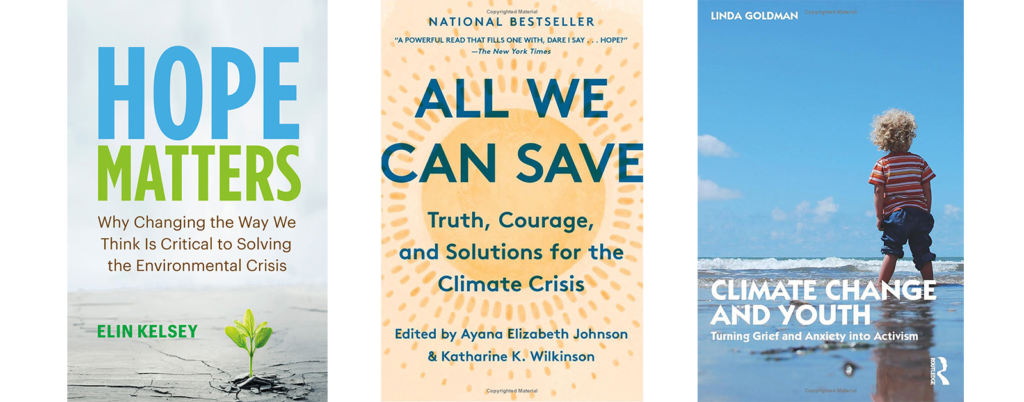The Power of the Possible: three summer reading books for educators on climate action

Over the past year, educators at many of GEBG’s member schools have shared that they are engaging with an increasing number of students around the global issue of climate change. As these educators consider how they might better teach the global competency of taking action and how they might support students in contributing to a more just and sustainable world as global citizens, many educators are thinking about or rethinking this issue. Some educators are designing specific curriculum units or courses, some are observing as students select this topic for assignments that involve student choice like research papers and capstone projects, some educators are creating immersive learning experiences on this topic in communities close to and far from campus, and some are empowering students through on-campus sustainability initiatives or events.
For those who are interested in climate-action education across the curriculum, I thought I would recommend three books as possible options for summer reading. Since May of 2022 I have read over a hundred books and articles on climate change and education as part of the two-year research study I am leading through the Klingenstein Center at Teachers College, Columbia University. There are a growing number of publications and a growing body of research on education around climate change. While many books focus on what isn’t being done to mitigate the impact of climate change or how schools are not doing enough, these three books highlight what is being done by educators, by community leaders, by young people, and by nature. Although they are not all written by and for educators, they all have tangible take-aways for working with students on and teaching for global citizenship.

Hope Matters: Why changing the way we think is critical to solving the environmental crisis (2020)
The first book I recommend is Hope Matters: Why changing the way we think is critical to solving the environmental crisis (2020) by Elin Kelsey, a Canadian scholar and educator. Kelsey’s research-based approach to outlining the importance of creating a narrative of possibility for students—rather than a narrative of inevitable doom—makes this book a worthwhile read for educators that are engaged in global education. We want our students to understand what is happening in the world: to build their awareness so that they will be motivated to do something about it and make it better. However, Kelsey outlines that on many issues, and in particular climate change, a lack of awareness is not what is holding students back from being engaged in action; What’s causing student inaction (or, for some, frantic action) is a lack of hope. Kelsey explains that “when teachers and other trusted adults take on the role of telling kids how wrecked the world is” in the name of building awareness or even educating them, “they fuel the cycle of fear, anxiety, and hopelessness” (p.65). This anxiety can sometimes lead to student action, but it can also directly lead to apathy or proverbial paralysis. The book goes on to highlight that educators can build understanding of the issue through directly connecting with what is being done to improve and address it. This shift in mentality to intentionally focus on the power of possibility and the way that students can contribute prevents the isolation and despair described by many researchers who study “climate anxiety” in youth. Educators can shape this narrative through their ability to “nurture the capacity to imagine something beyond what is” (p.56). Kelsey provides ample examples of what is working and what is possible when it comes to mitigating and adapting to the impact of climate change, including many ways that the natural world is adjusting and regenerating. Hope Matters is a book for educators looking to develop in students a sense of purpose, meaning, belonging, and connectedness with a world far beyond their classroom, and it might just give you hope too.
All We Can Save: Truth, courage, and solutions for the climate crisis (2021)
The book All We Can Save: Truth, courage, and solutions for the climate crisis (2021) edited by marine biologist Ayana Elizabeth Johnson and bestselling Drawdown author Katherine K Wilkinson provides numerous scientists, journalists, community leaders, poets, and experts with the chance to share their perspectives and actions. Centering the voices of women and BIPOC, the book organizes contributions into pieces that “root, advocate, reframe, reshape, persist, feel, nourish, and rise.” Each piece provides a perspective, narrative, insight, and inspiration that is unique—but together they contribute to that narrative of possibility that Kelsey asks us to emphasize for our students. The breadth of the contributors’ fields resonates with educators and students seeking to discuss climate issues well beyond the science classroom. Many of the pieces could be read by 7th-12th grade students, and many of the contributors could be a resource for educators looking to engage students with role models from a diversity of fields, identities, and global contexts. The meanings and messages are varied, but the book can be useful for educators by providing learning from multiple perspectives across multiple fields in one accessible text that can be picked up intermittently over the course of the summer.
Climate Change and Youth: Turning grief and anxiety into activism (2022)
The third book is Climate Change and Youth: Turning grief and anxiety into activism (2022) by Linda Goldman who is a teacher and counselor in schools as well as a trained grief therapist. Goldman focuses on helping educators and concerned adults to understand the impact that climate change is having on the mental health of our students. Reading Part 1 of this four-part book is like having an expert school counselor help you understand the connection between student anxiety and wellbeing and the climate crisis. For any school engaging in conversations about student mental health and student wellbeing, this is an essential and often under-discussed aspect of the current challenge and one that students struggle to articulate. Goldman combines her experience working with students and her expertise in grief to provide much needed insight into how the public conversation (or lack of it) around climate change is impacting our students, with plenty of research and data to support her claims. The latter three parts of the book focus on examples, models, and narratives of educators and youth engaging in climate action, as well as framing for adults to have conversations with our students or children about climate change. There are also examples of curriculum projects/units, as well as of organizations that provide additional resources and extensive reading lists. The writing style becomes a bit choppy, but the numerous practical examples, including photographs of student work, make it feel more like a helpful resource than a narrative. The examples and reading lists are especially useful for elementary/primary school educators (or parents) with students in pre-K through 5th grade.